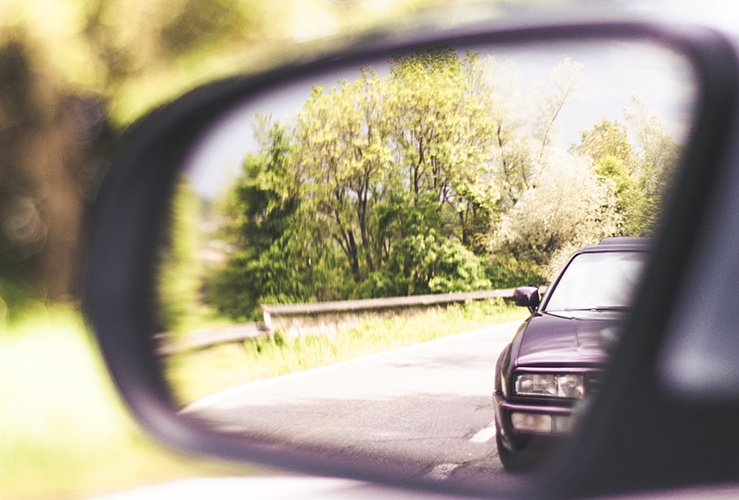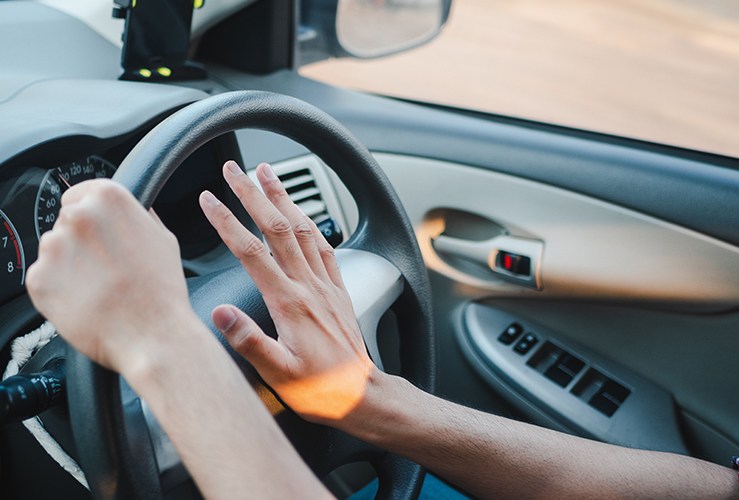Most - if not all - motorists get tailgated at some point. In all probability, you've been tailgated many times. These ‘space invaders’ can increase stress – and make driving a more dangerous affair.
A survey by CompareTheMarket revealed that being tailgated was the most common cause of road rage (35%), followed by slow driving (29%), drivers using their phone (29%) and lack of indication (29%).
Ironically, slow driving can trigger tailgating - and lead to an echo-chamber of road rage.
But what is the best way to deal with this frustrating behaviour?
First of all, How close is considered tailgating?
Tailgating is the act of driving too closely behind another vehicle. In extreme examples, the 'tailing' vehicle may be hanging back a few metres.
But in normal weather conditions, there should be a two second gap between vehicles, so anything under this could also be considered tailgating.
There should be a sufficient gap between vehicles so speed can be reduced safely if required.
Police can hand out £100 fines to those who engage in tailgating. Offenders can also be given 6 points on their licence.
According to the Highway Code:
"Tailgating is where the gap between you and the vehicle in front is too small for you to be able to stop safely if the vehicle in front suddenly brakes. Tailgating is dangerous, intimidating and can cause collisions, especially when driving at speed.
"Keeping a safe distance from the vehicle in front gives you time to react and stop if necessary. Dangerous and careless driving offences, such as tailgating, are enforced by the police."
tailgating is especially dangerous on motorways, due to the speeds involved. A high-speed collision is more likely to cause injury or death.
Why do people tailgate?
Tailgaters normally fall into one of three categories.
- They could be impatient, and exhibit 'bullying' behaviour on the road. They want other traffic to drive like they do, trying to impose higher speeds on drivers.
- They may be oblivious to their surroundings - perhaps distracted by passengers or even their smartphone. These drivers may be on 'autopilot'.
- They may be unaware of the dangers - simply 'locking on' to the rear of your vehicle and cruising along.
What might trigger a tailgater?
- The vehicle in front may be perceived to be driving too slowly.
- A vehicle may be 'hogging' one of the outside lanes (but tailgating a middle lane hogger would merely exacerbate the situation).
- The tailgater may feel as if they will reach their destination sooner by driving close to the vehicle ahead. But this can be especially pointless if that car is in front of another car and cannot pass.
How do I deal with a tailgater?
Here are some key ‘dos’ and ‘do nots’ when it comes to how to deal with tailgaters…
Do not:
- Do Not try to teach the tailgater a lesson by driving excessively under the speed limit with no fair reason.
- Do Not try to antagonise the tailgater by using your brake lights.
- Do Not let your fear increase your anger, thereby making the situation worse.
- Do Not "break check" anyone.
Do:
- Do try to diffuse the situation and reduce any risk.
- Do try to move left or park in if the road permits, so the tailgater can pass you safely.
- Do try to stay calm - you could talk yourself through how you intend to diffuse the situation.
- Do leave a larger gap between you and the vehicles ahead - this means if there is a problem ahead, you have enough time to react. You're essentially protecting the tailgater by doing this - because there is far less risk of you having to slow down suddenly.
- Do a full lap of a roundabout, meaning the tailgater is ahead of you (or could have taken another route).
- Do consider your own driving style - especially if you are being tailgated often.
Keeping a safe distance
To avoid inadvertently becoming a tailgater yourself, you need to leave enough space for the vehicle ahead to slow down safely if they need to.
As mentioned, on a motorway this space should equate to around two seconds of driving time. You can determine this by noting a point (such as a bridge or sign) that the vehicle ahead has reached, then counting 'one, two.' If you reach the noted position (bridge, sign etc.) in less than two seconds, you are too close to the vehicle ahead.
On A or B roads, or in built-up areas, the speed limit will be lower, but it’s still important to leave enough space for the vehicle ahead to slow down if they need to.
Managing space around your vehicle
Managing space around your vehicle is vital for the safety of you and your passengers, and of other road users. When traffic conditions are heavy, no one is likely to make any more progress than anyone else.
Motorists who won’t move left to aid traffic flow are simply adding to the problem. This increases the chance of impatient drivers tailgating these 'lane hoggers'.
Stubbornness in these scenarios often escalates, and invariably increases the risks for both vehicles - and potentially other road users.
Keeping your cool
It may be tempting to 'teach the tailgater a lesson'. However, 'brake checking' and other behaviours can increase the risk of a collision.
You might ask yourself: “Do I want to be right, or do I want to avoid a collision?”
Try not to get triggered, submit to the tailgater by letting them pass if it is safe to do so, and 'be the better person' by not giving in to anger.
Psychology of road rage
Commenting on the CompareTheMarket road rage survey, Neuro-linguistic expert Rebecca Lockwood suggested road rage can be influenced by several factors:
- A person may be stressed by other things in their life, and this may spill over into their driving habits.
- They may have grown up witnessing their parents exhibit road rage, and may have parroted this behaviour.
- Motorists can forget that other vehicles contain real people; the two cars dissociate one driver from another.
But of course, if drivers try to avoid actions such as tailgating – the number one cause of road rage – and brake checking, anger on our roads is less likely to appear.






